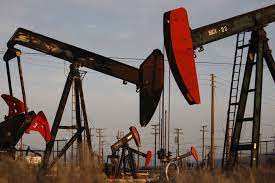Oilfield services groups are feeling the squeeze from a slowdown in activity in the US shale patch as companies scale back on oil and gas drilling.
The world’s biggest oilfield services providers, responsible for the industry’s grunt work from drilling wells to building roads, reported a hit to North American revenues this week amid dwindling demand.
“During the second quarter, we saw reduced frack activity that resulted in increased white space in our calendar,” said Chris Wright, chief executive of Liberty Energy, on a call with analysts.
Wright added that Denver-based Liberty, one of the country’s biggest providers of the hydraulic fracturing equipment used to blast open shale rock, could cut its number of fracking fleets in the second half of the year “if our customers’ scheduled work reductions become larger”.
The slide in business for oilfield services providers — seen as a bellwether for the health of the oil and gas industry — is the latest sign of a deceleration in activity in America’s energy heartlands that stretch from west Texas to North Dakota.
The tally of rigs and frack crews in the field has fallen consistently since late last year. Equipment has been offloaded at fire-sale prices and a recent survey carried out by the Dallas Federal Reserve reported the weakest sentiment since the depths
of the coronavirus pandemic.
Each of the three big international oilfield services groups — SLB, Baker Hughes and Halliburton — this week reported a slowdown in their North American business during the second quarter.
Halliburton, which is the most exposed of the three to the US onshore market, saw North American revenues contract by 2 percent on the back of decreased fracking activity, despite a strong offshore market in the Gulf of Mexico.
“The environment in North America has levelled off and we’re hearing some of the customers requesting discounts, particularly in the more commoditised markets like pressure pumping,” said Lorenzo Simonelli, chief executive at Baker Hughes.
The slowdown comes as many of the exuberant private operators that drove a surge in drilling over the past two years have either been swallowed by larger rivals or run out of inventory. Publicly traded groups had already been holding back as Wall Street imposed a strict regime of capital discipline and demanded spare cash be returned to shareholders.
The problem has been compounded by weak commodity prices.
Brent crude settled at just less than $80 a barrel on Friday, down more than a third since last year. US gas prices, meanwhile, have plunged from more than $6 per million British thermal units a year ago to less than $3.
“You had this double whammy of slower private operator growth coupled with weaker gas markets that finally drove the rig count lower,” said Jim Rollyson, an analyst at Raymond James.
Services groups are banking on rising international and offshore demand offsetting the shale patch decline. SLB, which does about 20 percent of its business in North America after offloading the bulk of its US fracking business in 2020, said international momentum was gathering.
“SLB’s global reach shields us from regional fluctuation, as we have recently seen in North America,” Olivier Le Peuch, the chief executive of the company formerly known as Schlumberger, told analysts this week.
“We believe that the lack of exposure to pressure pumping at scale has allowed us to continue to progress or to buffer some other activity decline.”
Halliburton boss Jeff Miller said he expected demand to continue to weaken in the second half of the year, but that an anticipated uptick in gas prices should improve matters in 2024.
While US oil output is still rising, growth is expected to be just 200,000 barrels a day over the next 12 months, well below the expansion of 2mn b/d reached between 2018 and 2019.
With producers vowing to stick to their newfound discipline even if prices rise, there is little expectation that the country will return to being the juggernaut of growth it became during the peak of the shale revolution.
“If you still believe the global demand picture for oil is higher over the coming years and the US isn’t growing the way it used to everywhere else has to fill that void,” said Rollyson at Raymond James.

 Iran Energy News Oil, Gas, Petrochemical and Energy Field Specialized Channel
Iran Energy News Oil, Gas, Petrochemical and Energy Field Specialized Channel



